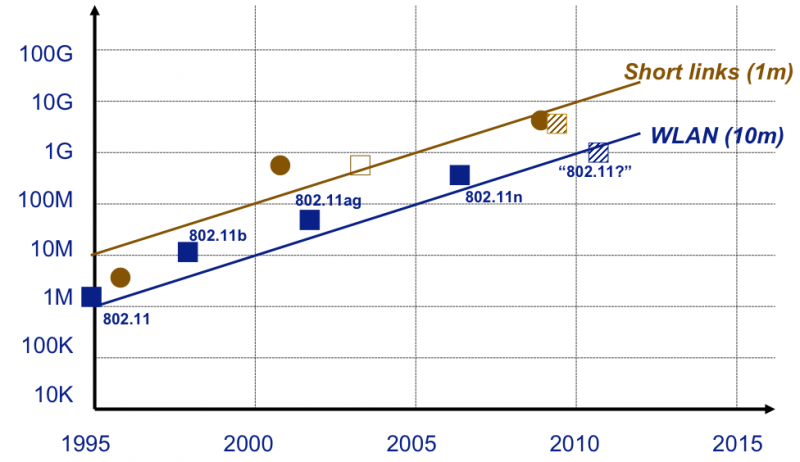Difference between revisions of "D3-WLAN Systems"
From its-wiki.no
Josef.Noll (Talk | contribs) |
Josef.Noll (Talk | contribs) (→"WLAN communication") |
||
| Line 9: | Line 9: | ||
* Book: CCNA Wireless. Oficial Exam Certification Guide | * Book: CCNA Wireless. Oficial Exam Certification Guide | ||
| − | = "WLAN communication"= | + | = "WLAN communication" 802.11= |
[[File:FettweisRadioDevelopment-WLAN.png|800px]] | [[File:FettweisRadioDevelopment-WLAN.png|800px]] | ||
<span scaled="60%>[Presentation G. Fettweis, IEEE VTC forum Baltimore], http://www.ieeevtc.org/plenaries/vtc2007fall/28.pdf </span> | <span scaled="60%>[Presentation G. Fettweis, IEEE VTC forum Baltimore], http://www.ieeevtc.org/plenaries/vtc2007fall/28.pdf </span> | ||
| + | |||
| + | = 802.11 ad standard = | ||
| + | {| | ||
| + | * addresses 60 GHz communications, 5.7 GHz available bandwidth | ||
| + | * Wavelength <math> \lambda = 0.5 </math> mm | ||
| + | * antenna on chip | ||
| + | |||
| + | Application areas: | ||
| + | * set-top boxes, TV, high-bandwidth cable replacement | ||
| + | * direct backbone links | ||
| + | * industrial construction area | ||
| + | * communications in public places | ||
| + | |- | ||
| + | Conclusions from NY University, [http://www.spectrum2020.ca/presentations/Rappaport.pdf] | ||
| + | * Measurements at 38 and 60 GHz show that NLOS links can be made with steerable antennas, with 20 – 30 dB loss compared to free space line-of-sight. | ||
| + | * A link was always made using steerable antennas within a 200 m cell radius. | ||
| + | * 38 GHz showed more NLOS links than 60 GHz | ||
| + | * Cellular AOA distributions show BS should be deployed site-specifically (due to shadowing of buildings) | ||
| + | * Worst RMS delay spread link was 122ns, similar for peer- to-peer and cellular | ||
| + | |||
| + | Further reading | ||
| + | |||
| + | * Measurements of 60 GHz http://www.sciencedirect.com/science/article/pii/S2405959515300187 | ||
| + | * 802.11ad explained http://cp.literature.agilent.com/litweb/pdf/5990-9697EN.pdf | ||
| + | |} | ||
Revision as of 20:49, 19 January 2016
| Wiki for ITS | ||||||
|---|---|---|---|---|---|---|
|
Susana Rodriguez de Novoa:
- Media:UNIK4700-Wlan.pdf
- Media:An_Introduction_to_wifi.pdf
- Media:radiomobile.pdf
- Media:WLANSecurity.pdf
- Book: Antennas and Propagation for Wireless Communication Systems. 2nd Edition
- Book: CCNA Wireless. Oficial Exam Certification Guide
"WLAN communication" 802.11
[Presentation G. Fettweis, IEEE VTC forum Baltimore], http://www.ieeevtc.org/plenaries/vtc2007fall/28.pdf
